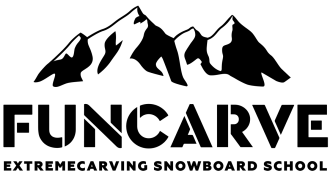Carving technique. Body Inclination
The first successes in carving depends on your ability to keep the basic position while riding the slope, smoothness of your movements and clear edging of the board. To compensate the centrifugal force you should incline into each turn.
To keep the board on the edge in running the slope you should keep your weight distribution strictly 50:50 between your legs and try to keep your centre of gravity in the middle of the sidecut. If you overload the nose of the board then the snowboard will drift, slow down and will not follow the path of the sidecut. If you overload the tail then your snowboard will be less responsive to your actions and will move in wider carves. At higher speeds mistakes in position of the center of gravity can result in the loss of speed, disrupted turns and falls.
Inclination is one of the ways of edging your board
Carving requires a sufficiently large angle of edging – the depth of inclination affects in direct proportion the stability of a turn. The deeper inclination the farther the centre of carver’s gravity from the pivot is and in the circular motion this condition guarantees the additional acceleration in every turn. The higher the speed the deeper inclinations you can make without being afraid of fall into the turn. Already when you run the slope for the first times you will feel a strong gain in speed, it is mainly due to more clear turns and smooth but a quick change of the edge. In order to ensure clear edging of the board corresponding to these speeds and to compensate the centrifugal forces you will have to incline deeper and deeper in the turn. At first the feelings of inclination are unusual and frightening but comparable to riding a rollercoaster.
One of the hardest things for a beginner is that the technique of inclinations means relaxed riding at maximum. It is important to understand that the control of the board – cutting or prolongation of a turn is made by inclination only. The deeper the carver inclines into the turn the shorter the carve will be. That is, the trajectory of movement is created immediately after the change of the edge and then you can focus on the basic position and balance. Or enjoy the surrounding beauty.
Typical mistakes
- Deviations from the basic position
Most often the basic position is lost on the frontside when the board is getting closer to perpendicular of the slope and a snowboarder is still looking down "the valley". This leads to the counter body twisting and too soon frontside disruption. Remember: regardless of your position on a slope keep your knees and shoulders correctly in relation to the board! - Uneven edging
The angle of board edging should be selected according to your speed otherwise the board will break away from the turn. That will come with experience, but from the very first riding try to achieve maximum precision in edging; - Unsure inclination into the turn
Immediately after changing the edge you should incline, it means you should do it in the phase of acceleration (green arrow). Unsure (and it means the last) inclination leads to the fact that your maximum angle of inclination falls on the last phase of the turn - phase of slowdown. Because of this the loss of speed is greatly increased; - Trying to make the board follow not its radius
Beginners often try to control the board by their legs forcing it to take a certain path. However, the entire phase of acceleration is spent for that and right after having made their board ride the path they want riders immediately get into the phase of slowdown. Let us recall you that in carving right after edge change the board still follows its path which it had before you changed the edge but on another edge already;
- Substitution of inclination by collapsing in turn
Inclinations are called so because of position of your body in motion. While learning this technique beginners often bend in their waist trying to increase the angle of edging with help of angulation in hip joint. At the same time the effectiveness of inclination comes to naught because the sufficient stiffness in the body is not provided in turn. It is necessary to keep your body in upright position focusing on parallelism between the planes of your shoulders and your board. Read more about the physics of inclination in the book "Piante Su!" by G.Gurshman; - On the backside you should keep an eye on the front shoulder, you shouldn’t cover yourself with it from the slope like from something dangerous. This movement is formed at the first stages of learning when fear prevails over your mind. At the stage of enhancement it will prevent correct inclination and rotation and also in such position rider looks awkward and clamped;
- In various situations, people reflexively align the position of their head with the horizon because this way it is easier for our brains to calculate the movements and to orientate. Being in inclination the entire weight of your body should go through your spine and legs right to the edge of the board. Aligning their head with the horizon people bend their neck, straighten shoulders and become bent in spine thereby partly decreasing load of the edge and partly amortising it. All this has a negative impact on backside turn. You have to overcome this reflex which we briefly call "eyes in the horizon," starting to perform the correct inclinations at low speed with head and internal shoulder in turn.




